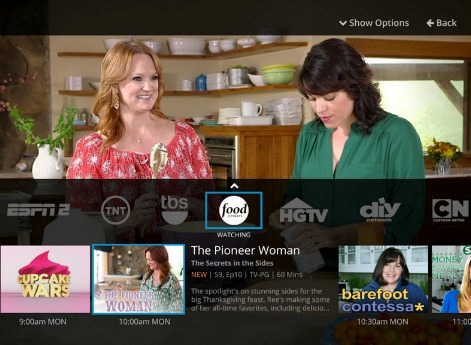CES: Dish Sling TV Streaming Service to Cost $20 a Month

Dish Network thinks cord-never, broadband-only consumers will pay $20 a month for Sling TV, its new over-the-top streaming product.
Unlike most broadband services offering programming on demand via streaming, Sling TV also offers live programming, headlined by the single most expensive cable channel ESPN (and ESPN2), which brings its assortment of popular sporting events to the party.
The low price is a result of cutting the number of traditional cable networks in the base product and not requiring customers to buy or rent equipment from Dish.
The new product was introduced Monday at the Consumer Electronics Show in Las Vegas and will be available in a few weeks, the company said.
It was created because Dish chairman Charlie Ergen saw a shift to streaming from pay TV, a saturated business that is losing subscribers.
The number of broadband only homes that do not subscribe to pay-TV via cable, satellite or telcos, has been rising, creating a market for over-the-top TV products. At the same time, the number of households getting broadcast over-the-air via antennas has been rising as well.
Sony is also planning an over-the-top service and several programmers, including CBS and HBO have launched or announced streaming products.
The smarter way to stay on top of broadcasting and cable industry. Sign up below
Not available via Sling TV’s basic package is live programming from the broadcast networks, which air nearly all of the highest rated shows. Dish plans to give customers a choice when it comes to accessing broadcast television. Customers can get an antenna and watch for free, over the air, freeing Dish from the cost of retransmission consent fees. On the other hand, Dish wants to put the broadcast programming in what it calls an add-on pack. Dish plans several thematic add-on packs. One would feature news and information programming; another might have kids and family content.
While not quite a la carte, the add-on packs would give more choice than they have now, says Roger Lynch, who was named CEO of Sling TV LLC. Lynch had been executive VP of advanced technologies for Dish.
Sling TV will be operated separately from Dish and is distinct from Dish’s Slingbox, which allows viewers to watch the same programming they have at home wherever they have an Internet connection.
ESPN owner Walt Disney Co. made a deal with Dish last year to be on the OTT service. Other Disney channels, including Disney Channel, ABC Family plus content from Internet video creator Maker Studios, a recent Disney acquisition, are part of the Sling TV basic launch package. Disney’s ABC broadcast network is not.
The basic programming lineup on Sling TV will feature about 20 channels. In addition to the Disney channels, it will include Scripps Networks Interactive’s Food Network, HGTV and Travel Channel as well as Turner Broadcasting’s TNT, CNN, TBS, Cartoon Network, and Adult Swim. Channels from A+E Networks, a joint venture of Disney and Hearst Corp., are also expected to be in the service as part of a carriage deal announced in August.
Nielsen is able to measure networks that are watched by Sling TV customers, now that broadband-only homes are included in the ratings service’s sample. All spots are served dynamically, which means networks have the flexibility to choose to run the same commercials as the broadcast within the three day C3 ratings window or sell ads streaming separately. The service also allows ads to be addressable and targeted to specific viewers.
To keep costs of the basic service low, Dish will have to limit the number of networks, which means that some programmers who have not already made deals with Dish may not get key channels included in Sling TV’s basic tier.
Dish seems to have identified most of the complaints consumers have with cable TV, and to some extent its satellite and telco pay-TV competitors. In an ad campaign for Sling TV, Dish uses the slogan “Take Back TV” to differentiate it from traditional pay TV, which features the nuisances of commitments, contracts, credit checks, installation and other hidden fees.
The campaign will air on TV, but Dish does not want to cannibalize its satellite business. Lynch said that when Dish launched an over-the-top service offering international channels in 2013, only 2% of its customers ever had a Dish account. He added that the customer base for the OTT service is likely to be different than the Dish subscriber profile.
Sling TV is likely to attract a younger consumer. “The pay TV model and programming lineup meets the needs of the majority of pay TV subscribers, but it has alienated others,” says Lynch, who calls 18 to 34 year olds the “the generation that pay TV forgot.” He says that “millennials are getting out of school and pay TV doesn’t meet their needs” because the price keeps rising and it requires too much of a commitment.
Dish says that with most live channels and VOD content, Sling TV users will be able to pause, rewind and fast forward. The service will also feature 3-Day Replay, which will allow viewers to watch most shows that have aired in the past three days without a DVR.
Sling TV will be available anywhere a customer has a wired, WiFi or mobile broadband connection. A cloud-based delivery system uses adaptive bitrate streaming technology, which Dish says provides a high quality viewing experience. Dish acquired the technology when it bought Move Networks in 2011.
“They were very good at developing technology, but not so good at commercializing it,” said Lynch. At the same time, it took Dish a while to line up streaming rights from programmers, partly because the programmers, studios and other rights holders needed to make deals among themselves, he said.
Sling TV will work with a variety of TV, tablet, computers, smart phones and set top boxes. Those include Mac and PCs, Amazon Fire TV, Amazon Fire TV Stick, Google Nexus player, Roku 3, Roku Streaming Stick, Roku LT and Xbox One. It is available on supported versions of Apple’s iOS and Google’s Android mobile operating systems.
Dish also planned to make two other announcements at CES:
• The company said it will introduce a new remote control that’s smaller, with fewer buttons in order to simplify navigation. The remote features a clickable touchpad that includes the device’s number buttons and enables voice commands including contextual searching for programming.
• The Dish Hopper interface has been updated, with a new carbon color scheme, a smoother flow from option to option.
• Dish will also add non-TV programming services to its lineup, including music from Pandora, iHeartRadio and TuneIn, as well as music videos from Vevo.
• Dish also introduced its first 4K pay-TV receiver to play back ultra-high definition programming. The company said it would announce on demand content partners and that the Joey—which works with Dish’s Hopper—would be available this summer.
Jon has been business editor of Broadcasting+Cable since 2010. He focuses on revenue-generating activities, including advertising and distribution, as well as executive intrigue and merger and acquisition activity. Just about any story is fair game, if a dollar sign can make its way into the article. Before B+C, Jon covered the industry for TVWeek, Cable World, Electronic Media, Advertising Age and The New York Post. A native New Yorker, Jon is hiding in plain sight in the suburbs of Chicago.

